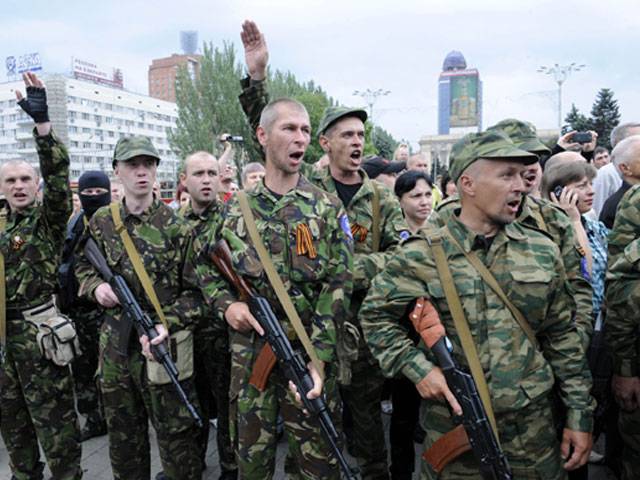Peter Apps
Only last year, the U.S. European Command was facing some of the deepest cuts of any region in the U.S. military. Now, after Russia’s annexation of Crimea, the Pentagon finds itself focusing on the continent in a way not seen in decades.
Earlier this month, U.S. President Barack Obama said he would ask Congress for an additional $1 billion to increase Washington’s military commitment to the continent. Last week, the U.S. Air Force said it had deployed two B-2 stealth bombers to England, joining two B-52s sent earlier this month. The two aircraft are America’s premier nuclear bombers.
Washington has sent additional warships to the Black Sea and the Baltic, F-15, F-16 jets and early warning AWACS aircraft to join ramped up NATO patrols near Russian airspace and troops to train in Germany and Eastern Europe. With fighting raging in eastern Ukraine between pro-Moscow forces and troops loyal to Kiev, Washington says Russia has put large numbers of troops on the border and may be preparing to deliver tanks and artillery to the separatists.
At a time of budget cuts and when Obama would rather focus its strategic gaze on Asia and the Middle East, resources are limited and few expect America to rebuild the permanent garrison-type presence set up in Europe during the Cold War. While more military supplies will be placed in the European region, U.S. units will be largely rotated through from existing European bases and elsewhere.
Washington also wants European states to step up more. ‘Collective action doesn’t mean the United States puts skin in the game while others stand on the sidelines cheering,’ U.S. National Security adviser Susan Rice told the annual conference of the Centre for a New American Security.
Although the United States has pledged to strengthen the military capabilities of non-NATO states near Russia such as Ukraine, Georgia and Moldova, officials say no decisions have been made on details and the real focus is on boosting NATO’s defenses. In November, U.S. Air Force General Philip Breedlove, the head of the U.S. European Command, said the force had been told to prepare cuts of up to 20 percent, twice that of some other regions, although a congressional budget deal the following month watered down the cuts in the military as a whole.
TANKS AND TROOPS
For now, few military analysts or western officials believe Russian President Vladimir Putin intends to invade any NATO state. Since 2008, Moscow has increased its defense spending some 30 percent. However, Russia’s estimated budget of $68 billion annually is dwarfed by Washington’s $600 billion and remains smaller than the military spending of Britain, France and Germany combined.
Still, the number of forces Moscow can mobilize at speed often outstrips anything the United States or NATO can field, although experts say much Russian equipment remains outdated.
According to the London-based International Institute for Strategic Studies, Russia has some 845,000 military personnel, more than 2,500 main battle tanks and thousands of armored personnel carriers and infantry fighting vehicles. Shortly before annexing Crimea in March, Moscow mobilized about 150,000 personnel in its western military district.
The United States has some 67,000 military personnel in Europe, 10,000 of them part of the Stuttgart-based Africa Command (AFRICOM). After the annexation of Crimea, it sent 600 paratroopers from a brigade based in Italy to Poland and the Baltic States of Estonia, Latvia and Lithuania.
Washington has also said it will maintain a presence of some 100 U.S. Army Special Forces in Eastern Europe. At the start of the year, the U.S. Army had no tanks in the continent at all, although European NATO states have more than 1,000. As with Russia, some of them are distinctly outdated. In January, the U.S. Army moved more than 50 M1A1 Abrams tanks and Bradley armored fighting vehicles into Germany specifically to be used by visiting troops for training.
In any emergency, the United States has long pledged several thousand personnel to the NATO Response Force including a brigade combat team from the Texas-based 1st Cavalry Division, a hospital ship, air-to-air refueling tankers and escort ships. The United States sends a smaller battalion-sized unit - roughly one-third the size of a brigade - twice a year for two months for exercises in Europe. So far this year, such groups have been involved in drills in France and Germany - just the kind of deployment the United States believes is likely to become more common.–Reuters
Tuesday, April 16, 2024
Ukraine crisis forces US to bolster Europe forces

Caption: Ukraine crisis forces US to bolster Europe forces
CM Maryam reviews medical facilities at THQ hospital Murree
8:34 PM | April 16, 2024
Neither Hezbollah nor Iran currently ready for war, says EU foreign policy chief
4:14 PM | April 16, 2024
Saudi foreign minister meets PM Shehbaz Sharif
1:17 PM | April 16, 2024
Decision to retaliate against Iran attacks rests with Israel, says Pentagon
1:05 PM | April 16, 2024
Elon Musk proposes small fee for new X users to combat fake accounts
1:01 PM | April 16, 2024
Political Reconciliation
April 16, 2024
Pricing Pressures
April 16, 2024
Western Hypocrisy
April 16, 2024
Policing Reforms
April 15, 2024
Storm Safety
April 15, 2024
Democratic harmony
April 16, 2024
Digital dilemma
April 16, 2024
Classroom crisis
April 16, 2024
Bridging gaps
April 16, 2024
Suicide awareness
April 15, 2024
ePaper - Nawaiwaqt
Advertisement
Nawaiwaqt Group | Copyright © 2024





